2001 – This article was posted about three weeks before Mac OS X 10.0 first shipped, so it reflects the reality under Mac OS 9.1. OS X has far better multiprocessor support, which Bare Feats demonstrated in an October 2001 comparison of single- and dual-processor G4 Power Macs using OS X 10.1.
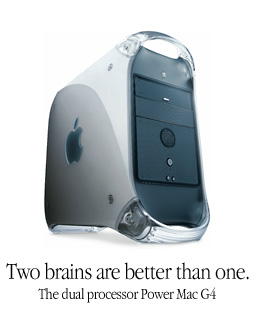 Remember last July when Apple introduced the dual-processor Mystic Power Macintosh G4 with the slogan “Two Brains Are Better than One”?
Remember last July when Apple introduced the dual-processor Mystic Power Macintosh G4 with the slogan “Two Brains Are Better than One”?
Remember January 2001, when Apple replaced those with mostly single-processor models?
The 2001 Digital Audio Power Mac G4 offers some real advantages over those 2000 models: a 133 MHz system bus, AGP 4x video, Nvidia GeForce 2 MX video, CD-RW, faster CPU speeds, and – for the first time – the option of burning your own DVDs. There are even two different G4 processors: the 7410 in the 466 and 533 MHz models and the more powerful 7450 in the 667 and 733 MHz machines.
But is one 733 MHz brain better than two 533 MHz brains?
That’s the question Rob Art Morgan at Bare Feats, along with a lot of other Mac users, has been asking. Now that the 733 MHz G4 is available, Rob Art has been busy benchmarking it against the lone dual-processor configuration Apple currently offers, a Power Mac with twin 533 MHz G4 processors.
So far, the results are mixed – but looking at the price difference, a clear winner emerges.
The Tests

The first benchmark test use iMovie 2.0 to export a 46 second movie. As expected, the 733 MHz model handily outperforms the single processor 533 MHz Power Mac. The dual 533 MHz isn’t much faster than the single 533 model. Winner: 733 MHz

For the second benchmark, Rob Art rips three Beach Boys songs from the Power Mac’s hard drive in iTunes (the SuperDrive in the 733 MHz model is much slower than the CD-RW drives in the 533 MHz machines, and Bare Feats was testing CPUs, not optical drives). The dual 533 wins this comparison by a big margin. Winner: Dual 533
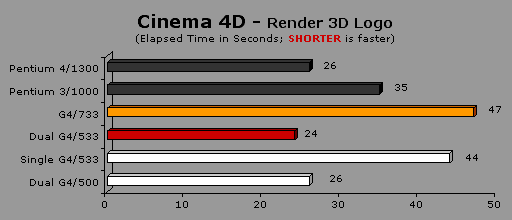
Benchmark three is rendering a 3D logo in Cinema 4D. In this comparison, the single processor G4/533 beats the G4/733. The dual 533 configuration is roughly twice as fast as the single G4/733. Rob Art speculates the smaller cache and longer data pipes in the PowerPC 7450 are causing this unexpectedly poor showing. Winner: Dual 533
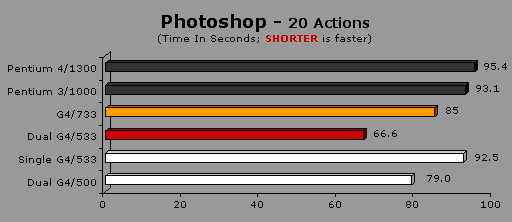
Benchmark four runs 20 actions within Photoshop and probably better approximates what top-end G4 users will be doing at work. The single CPU 533 runs these actions in 92.5 seconds, the 733 trims that to 85, and the dual 533 reduces the time down to 66.6 seconds. Winner: Dual 533
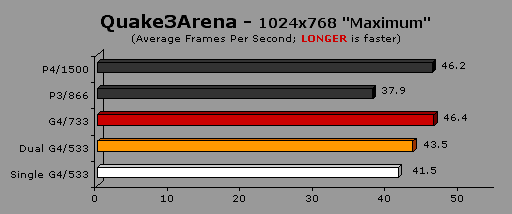
Gamers will find the following benchmarks most interesting. Running Quake 3 Arena at 1024 x 768 and “maximum”, the 733 with Nvidia GeForce graphics edges out the dual 533 by almost 3 frames per second (FPS). Interestingly, a dual G4 configured with an ATI Radeon card outperforms that. Still in the default configuration, the 733 MHz model won another test. Winner: 733 MHz
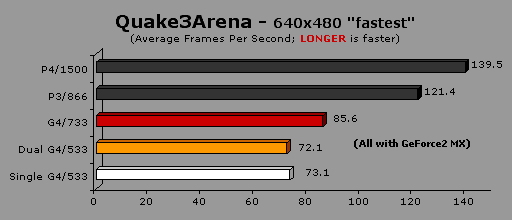
Running Quake 3 Arena at the low resolution of 640 x 480 in “fastest” mode, with Nvidia GeForce 2 MX graphics in all G4 machines, the 733 MHz Power Mac G4 wins by 12.5 FPS over the single 533, which edges out the dual 533 by 1 FPS. Winner: 733 MHz

The final gaming test is Unreal Wicked 400, also running at low resolution 640 x 480 and in low quality mode, using both OpenGL and RAVE graphics. The 733 wins the OpenGL test by nearly 6 FPS, while the dual 533 with Radeon graphics edges out the 733 by 1.7 FPS. The 733 beats both versions of 533 MHz Power Mac G4 when they use Nvidia GeForce graphics, showing the faster CPU delivers the goods when used with the same graphcis card. Winner: 733 MHz
Overall, the 733 MHz model wins 4 comparisons, the dual 533 takes just 2.
The Value
Performance is wonderful, but Low End Mac has a greater interest in value. At my last job, we never ordered the fastest Macs, because dropping back one or two levels provided excellent performance at a much more attractive price.
We also have a very practical perspective on things and believe that once you get past a 300 MHz G3 Mac, most of the time most users will be pretty darned happy with their computer. In today’s MHz sweepstakes, we keep wondering why anyone needs more than 400 MHz. At Low End Mac headquarters, we’re thrilled with our 400 MHz PowerBook G4 – and also with the money we saved compared with the far more costly 500 MHz model.
Today we’ll compare the third and fifth values on the Power Mac G4 page at the Apple Store.
- Dual 533, 1 MB L2 cache, 128 MB RAM, 40 GB drive, CD-RW, GeForce video, 56k modem, $2,499
- Single 733, 256 KB L2 cache, 1 MB L3 cache, 256 MB RAM, 60 GB hard drive, CD-RW (not SuperDrive), 56k modem, $3,099
Not exactly comparing apples and oranges. Part of the $600 difference comes from more memory and a larger hard drive. Since Apple won’t sell the 733 with less than 256 MB RAM or that 60 GB drive, we’ll make the dual 533 match:
- Dual 533, 1 MB L2 cache, 256 MB RAM, 60 GB drive, CD-RW, GeForce video, 56k modem, $2,799
Of course, in the real world you’d be smart enough to buy memory anywhere but Apple, wouldn’t you? A quick visit to ramseeker shows you could buy two or three 256 MB sticks of PC133 memory for the $200 the Apple Store ads to bring you from 128 to 256 – you do the math!
Assuming you pick up the memory for about $80, here’s the deal.
- Dual 533, 1 MB L2 cache, 256 MB RAM, 60 GB drive, CD-RW, GeForce video, 56k modem, $2,679
You also have the choice between the stock Nvidia card and the ATI Radeon at the same price. If you’re a serious gamer, you’ll want to think through your options here.
The Value Equation
The dual 533 won only two of six benchmarks. Similarly configured to the CD-RW version of the 733 MHz model, it comes in at $420 less, saving you almost 16%.
With OS X due out in less than three weeks with full multiprocessor support, at which should make the dual 533 more comparable performance overall, and the option of saving over $400, the “two brains are better than one” models looks like the no brains choice for performance and value if you need top-end performance.
If you don’t need that level of performance, we’d steer you to the single-processor 466 MHz model, which you can pick up for as little as $1,649 if you don’t need an internal modem.
It’s too bad the SuperDrive isn’t an option on the dual 533; it would really give the $3,499 733 MHz G4 with SuperDrive a run for the money.
Of course, this isn’t the end of the story. As Motorola ramps up production, we may someday see dual 733 machines.
Some will claim that Bare Feats’ benchmarks put the new 7450 processor at a disadvantage, since the programs and Mac OS haven’t yet been optimized for the extra integer and AltiVec units in the new CPU (see our guide to PowerPC processors for more on that). Of course, if you buy the computer today, you don’t have those optimized programs, either.
We’re not buying – we’re thrilled with our Titanium PowerBook – but if we had a reason to buy a high-end production machine, we’d give the nod to the “two brains are better than one” dual-processor 533 MHz Power Mac G4.

